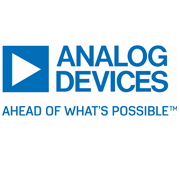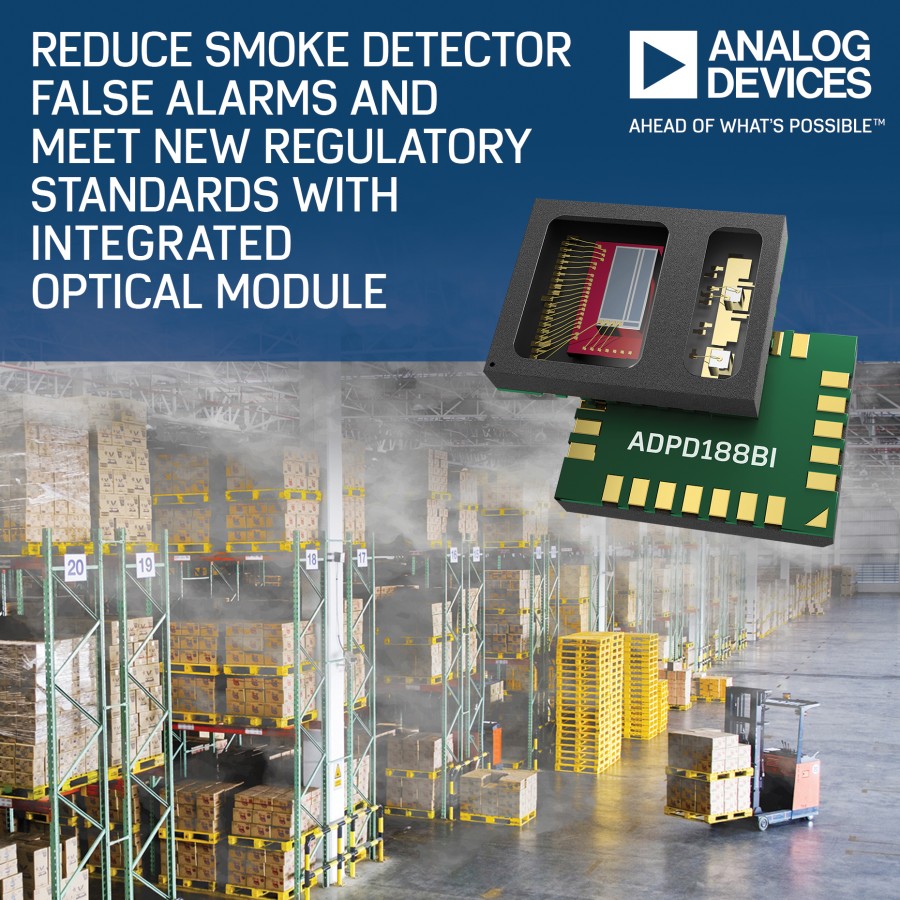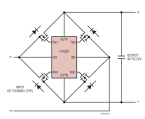Analog Devices Ltd
Analog Devices, Inc. operates at the centre of the modern digital economy, converting real-world phenomena into actionable insight with its comprehensive suite of analogue and mixed signal, power management, radio frequency (RF), and digital and sensor technologies. ADI serves 125,000 customers worldwide with more than 75,000 products in the industrial, communications, automotive, and consumer markets. ADI is headquartered in Wilmington, MA. Visit www.analog.com. Both Linear Technology and Maxim Integrated are now part of Analog Devices.
Analog Devices provide efficient solutions for power management and power conversion applications in the automotive, telecommunications, industrial, medical, computing, military and high-end consumer markets using high-performance analogue ICs. Our power ICs can provide unrivalled power densities and software design simulation tools to provide both fast and accurate power module and power supply designs.
Products for power management include: switching regulators, linear regulators (LDO), µModule regulators, PMIC & Multifunction, inductorless (charge pump) DC/DC converters, LED driver ICs, power control, battery management, current source, system supervisor, hot-swap controllers, monitor and control, energy harvesting, super capacitor chargers and power management evaluation kits.
Filter products and services
-
High Efficiency PoE++ PD Controllers Provide up to 90W Delivered Power
The LT4275 is a LTPoE++, PoE+ and PoE-compliant powered device (PD) interface controller for applications requiring up to 90W of delivered power. PoE+ limits the maximum PD power delivery to 25.5W, which is insufficient to power today's new class of power-hungry applications, such as picocells, base stations, signage and heated outdoor cameras. Linear Technology's LTPoE++ standard addresses this market by expanding the power budget to four different power levels 38.7W, 52.7W, 70W and 90W enabling complete high power LTPoE++ systems. The LTPoE++ standard employs a classification scheme that simply enables LTPoE++ power sourcing equipment (PSE) controllers and LTPoE++ PD controllers to reliably communicate with one another while maintaining interoperability with IEEE standard equipment. The LT4275A (LTPoE++), LT4275B (PoE+) and LT4275C (PoE) efficiently deliver power to PD loads using just one IC.Unlike traditional PD controllers that integrate the power MOSFET, the LT4275 controls an external MOSFET to drastically reduce overall PD heat dissipation and maximize power efficiency, especially important at higher power levels. This novel approach allows users to size the MOSFET to their application's specific heating and efficiency requirements, enabling the use of low RDS(ON) 30mOhm MOSFETs if necessary. The LT4275 recognizes a PSE as either Type 1 hardware complying with the IEEE 802.3af 13W power level, Type 2 hardware, complying with IEEE 802.3at 25.5W power level or LTPoE++ hardware complying with 38.7W to 90W power levels, and passes power accordingly. The LT4275 is offered in industrial and automotive grades supporting operating temp ranges from -40°C to 85°C and -40°C to 125°C. It is available in small 10-pin MSOP or 3mm x 3mm DFN packages and is priced starting at $1.45 each in 1,000-piece quantities.Request a Quote Supplied by Analog Devices Ltd -
Ideal Diode Bridge Controller minimises Rectifier Heat & Voltage Loss
The LT4320 is an ideal diode bridge controller for 9V to 72V systems that replaces each of the four diodes in a full-wave bridge rectifier with a low loss N-channel MOSFET to significantly reduce the power dissipation and increase available voltage.
Power supply size is reduced as the enhanced power efficiency eliminates bulky heat sinks. Low voltage applications benefit from the extra margin afforded by saving the two diode drops inherent in diode bridges. Compared to the traditional alternative, the MOSFET bridge enables a rectifier design that is highly space- and power-efficient. The controller operates from DC to 600Hz.
The LT4320 switch control smoothly turns on the appropriate two MOSFETs, while keeping the other two off to prevent reverse currents. An integrated charge pump provides the gate drive for the external low on-resistance N-channel MOSFETs without requiring external capacitors. The choice of MOSFETs offers the greatest flexibility in power levels ranging from one to thousands of watts.
The LT4320 is available in two options: the LT4320 is designed for DC to 60Hz voltage rectification, whereas the LT4320-1 rectifies DC to 600Hz.
Specified over the -40°C to 85°C industrial temperature range, the LT4320 is offered in a compact 8-pin 3mm x 3mm DFN package, and a 12-lead MSOP package with enhanced high-voltage pin spacing.
Priced beginning at $2.95 each for 1,000-piece quantities, the device is available today in production quantities. Evaluation circuit boards are available online or from your local Linear Technology sales office.
For more information, visit www.linear.com/product/LT4320.Request a Quote Supplied by Analog Devices Ltd -
Ideal Diode Bridge Controller Minimizes Rectifier Heat & Voltage Loss
The LT4320 is an ideal diode bridge controller for 9V to 72V systems that replaces each of the four diodes in a full-wave bridge rectifier with a low loss N-channel MOSFET to significantly reduce the power dissipation and increase available voltage.Power supply size is reduced as the enhanced power efficiency eliminates bulky heat sinks. Low voltage applications benefit from the extra margin afforded by saving the two diode drops inherent in diode bridges. Compared to the traditional alternative, the MOSFET bridge enables a rectifier design that is highly space- and power-efficient. The controller operates from DC to 600Hz.The LT4320 switch control smoothly turns on the appropriate two MOSFETs, while keeping the other two off to prevent reverse currents. An integrated charge pump provides the gate drive for the external low on-resistance N-channel MOSFETs without requiring external capacitors. The choice of MOSFETs offers the greatest flexibility in power levels ranging from one to thousands of watts.The LT4320 is available in two options: the LT4320 is designed for DC to 60Hz voltage rectification, whereas the LT4320-1 rectifies DC to 600Hz.Specified over the -40°C to 85°C industrial temperature range, the LT4320 is offered in a compact 8-pin 3mm x 3mm DFN package, and a 12-lead MSOP package with enhanced high-voltage pin spacing.Priced beginning at $2.95 each for 1,000-piece quantities, the device is available today in production quantities. Evaluation circuit boards are available online or from your local Linear Technology sales office.Request a Quote Supplied by Analog Devices Ltd -
Inverting, Boost or Buck-Boost µModule Converter Delivers up to 700mA with Only Four Small Passive Components
The LTM8045 is a 2.8V-18V input, multi-topology DC/DC µModule converter, with onboard inductor, power switch and DC/DC controller delivering up to 700mA output current. With the addition of only two resistors and two capacitors, the LTM8045 can be configured to regulate either a positive output voltage (SEPIC topology) between 2.5V and 15V or a negative output voltage (inverting topology) between -2.5V and -15V. The LTM8045 is designed for point-of-load regulation in communications, imaging and handheld test equipment.In the SEPIC configuration, the LTM8045's input voltage can be above, below or equal to the regulated output voltage. If configured as a negative output inverter, no level shifting circuitry is required by the logic level control pins. Under a -5V, 500mA load, the LTM8045 achieves 80% efficiency from a positive 12V input supply. The operating frequency range is 200kHz to 2MHz, adjustable via an external resistor and can be synchronized to an external clock within the same frequency range.The LTM8045 is packaged in a 6.25mm x 11.25mm x 4.92mm BGA and operation is guaranteed over the -40°C to +125°C and -55°C to +125°C internal temperature range. Pricing starts at $6.97 each for 1,000 piece quantities.Request a Quote Supplied by Analog Devices Ltd -
I/Q Sampling Digital Predistortion Receiver Enables Acquisition of 300MHz Bandwidth in Base Station Applications
The LTM9013 is a wideband RF-to-digital µModule receiver that includes a high performance dual 14-bit, 310Msps analog-to-digital converter (ADC), a high IIP3 I/Q demodulator, two variable gain amplifiers, and 300MHz lowpass filters.The quadrature sampling architecture enables acquisition of up to 300MHz of signal bandwidth with IMD3 performance of 66dB across the entire band. The receiver is targeted for wideband, low IF receivers and wireless base stations implementing power amplifier (PA) linearization with digital predistortion (DPD).This device leverages years of applications design expertise to offer high integration, ease of use, with repeatable and guaranteed system performance to increase production yields and time to market.Due to increasing data demands from mobile users, next-generation base stations are now architected to achieve much higher transmit bandwidths of up to 60MHz. To linearize a transmit bandwidth of 60MHz, the predistortion feedback loop for the linearization algorithm must acquire fifth order intermodulation products out to 300MHz. Digitizing the fifth order intermodulation distortion requires a very wide bandwidth, low noise receiver with an exceptionally flat passband.The LTM9013 includes a 300MHz lowpass filter that exhibits less than 1.3dB passband ripple across the entire band and the internal ADC has just 5 clock cycles of latency.The LTM9013 is packaged in a space-saving 15mm x 15mm ball grid array (BGA) package, utilising a multilayer substrate that shields sensitive analog lines from the digital traces to minimize digital feedback. Supply and reference bypass capacitance is placed inside the µModule package, tightly coupled to the die, providing space, cost and performance advantages over traditional packaging. The LTM9013 is priced starting at $65.00 each in 1,000 piece quantities. Demo boards are available.Request a Quote Supplied by Analog Devices Ltd -
Isolated 8-Port PoE PSE Controllers Eliminate Optos for Lowest Solution Cost
The LTC4290/LTC4271 is an isolated 8-port power source equipment (PSE) controller chipset designed for use in IEEE 802.3at (PoE+) Type 1- and Type 2-compliant Power-over-Ethernet (PoE) systems.This chipset provides 8 independent PSE channels for simpler lower component count designs, reduced board space and ultimately reduced total solution costs.The LTC4271 provides a digital interface to the PSE host, whereas the LTC4290 provides the high voltage Ethernet interface; the two ICs are then bridged by an inexpensive Ethernet transformer.The transformer-isolated communication protocol replaces up to six expensive opto-couplers and a complex isolated 3.3V supply used in traditional designs, resulting in significant cost savings and a more robust and easy to manufacture design.This chipset earns a 100% interoperability score for PoE+ and PoE systems in popular compliance tests. When paired with the LT4275 PD (powered device) controller, complete end-to-end LTPoE++ systems can deliver up to 90W while remaining fully compatible with PoE+ and PoE.Users will appreciate the robustness provided by 80V port pins and lowest-in-industry power dissipation, making thermal design significantly easier than when designing with PSEs integrating more fragile normally-higher-RDS(ON) MOSFETs. The LTC4290 is offered in three power grades: 'A' grade uses Linear Technology's LTPoE++ signaling to support 38.7W, 52.7W, 70W and 90W PDs; 'B' grade uses PoE+ signaling to support up to 25.5W PDs; and 'C' grade uses PoE signaling to support up to 13W PDs. All chipsets are offered in industrial temperature ranges.The LTC4290 is in a RoHS-compliant 40-pin 6mm x 6mm QFN package, while the LTC4271 is in a 24-pin 4mm x 4mm QFN package. The LTC4290/71 chipset is priced starting at $10.00 each in 1,000 piece quantities.Request a Quote Supplied by Analog Devices Ltd -
isoSPI transceiver that enables bidirectional transmission of the Serial Peripheral Interface bus (SPI) across an isolated barrier up to 100 metres
Along with the LTC6804, Linear Technology has introduced the LTC6820 isoSPI transceiver. This device enables bidirectional transmission of the Serial Peripheral Interface bus (SPI) across an isolated barrier up to 100 metres.
With the LTC6820, the SPI data is encoded into a differential signal, which is then transmitted via twisted pair and a simple, inexpensive Ethernet transformer. The LTC6820 supports SPI data rates up to 1MHz, using matched source and sink currents to eliminate the need for a transformer center tap and to reduce EMI. The drive currents and the comparator thresholds are set with two resistors, allowing the system to be optimised for cable length and signal-to-noise performance.
The LTC6820 is a companion to the LTC6804 high voltage battery monitor with its built-in isoSPI interface. Battery management systems using the LTC6804 can interface to external components, such as microcontrollers, via the LTC6820.
The LTC6820 is offered in an MSOP and tiny QFN package and is priced at $2.29 each in 1,000-piece quantities. Samples, demonstration boards and the data sheet are available at www.linear.com/product/LTC6820.Request a Quote Supplied by Analog Devices Ltd -
LF155A - JFET-Input Operational Amplifiers Low Supply Current (LF155) High Speed (LF156)
The H (Metal Can), J (Ceramic), and K (Metal Can) Packages From Linear Technology Are Now ObsoleteLinear Technology's LF155/156 series features several improvements compared to similar types from other manufacturers: offset voltage drift with temperature and slew rate are guaranteed on all grades, not just on the more expensive "A" grades. Other specifications such as voltage gain and high temperature bias and offset currents are also improved.The industry standard LF155/156 devices exhibit phase reversal at the output when the negative common-mode limit at the input is exceeded (i.e., from - 12V to - 15V with ±15V supplies). This can cause lock-up in servo systems.As shown below, Linear Technology's LF155/156 does not have this problem due to unique phase reversal protection circuitry. For applications requiring higher performance, see the LT1055 and LT1056 data sheets.Request a Quote Supplied by Analog Devices Ltd -
LF155 - JFET-Input Operational Amplifiers Low Supply Current (LF155) High Speed (LF156)
The H (Metal Can), J (Ceramic), and K (Metal Can) Packages From Linear Technology Are Now Obsolete Linear Technology's LF155/156 series features several improvements compared to similar types from other manufacturers: offset voltage drift with temperature and slew rate are guaranteed on all grades, not just on the more expensive "A" grades. Other specifications such as voltage gain and high temperature bias and offset currents are also improved. The industry standard LF155/156 devices exhibit phase reversal at the output when the negative common-mode limit at the input is exceeded (i.e., from - 12V to - 15V with ±15V supplies). This can cause lock-up in servo systems. As shown below, Linear Technology's LF155/156 does not have this problem due to unique phase reversal protection circuitry. For applications requiring higher performance, see the LT1055 and LT1056 data sheets.Request a Quote Supplied by Analog Devices Ltd -
LF156A - JFET-Input Operational Amplifiers Low Supply Current (LF155) High Speed (LF156)
The H (Metal Can), J (Ceramic), and K (Metal Can) Packages From Linear Technology Are Now ObsoleteLinear Technology's LF155/156 series features several improvements compared to similar types from other manufacturers: offset voltage drift with temperature and slew rate are guaranteed on all grades, not just on the more expensive "A" grades. Other specifications such as voltage gain and high temperature bias and offset currents are also improved.The industry standard LF155/156 devices exhibit phase reversal at the output when the negative common-mode limit at the input is exceeded (i.e., from - 12V to - 15V with ±15V supplies). This can cause lock-up in servo systems.As shown below, Linear Technology's LF155/156 does not have this problem due to unique phase reversal protection circuitry. For applications requiring higher performance, see the LT1055 and LT1056 data sheets.Request a Quote Supplied by Analog Devices Ltd











